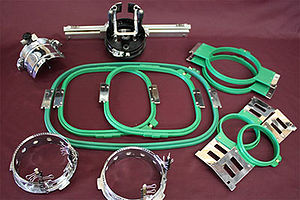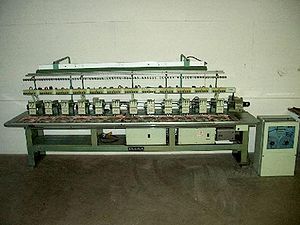Industrial/Commercial Embroidery Machine
An Industrial or Commercial Embroidery Machine is an embroidery machine designed for production, or commercial embroidery. An industrial embroidery machine generally has more than one needle where each needle is used for a different colored thread. An industrial or commercial embroidery machine is different from a home or family type machine. Generally Home or Family machines have only one needle or, are more plastic based. Industrial machines run much faster than home machines and are built much more durable for production work.
Examples of Home or Family machines include Bernina, Janome, etc. Examples of commercial embroidery equipment includes Tajima, Barudan, SWF, Melco, Toyota, Brother. Note, that Brother also makes home and family machines.
Industrial embroidery machines require that the files be digitized on a computer and then uploaded to the embroidery machine as a data file. The data file includes information on each single stitch and the direction the machine needs to move to make the stitch. In the data file there are also all the commands such as the needle up commands to make the machine lift the needle up without sewing, trims, color changes, etc.
Accessories & Attachments
Embroidery machines use several types of Embroidery Machine Accessories for creating a wider variety of embroidered goods, or for making life easier on the operator. Common accessories include a 270 Cap System, hoops, and various attachments. Depending on the age of the machine certain accessories may or may not be available.
Brands of Commercial Embroidery Equipment
There are several different major commercial embroidery machine companies across the USA.
These same models are generally popular across the entire world wherever production embroidery is done.
The most well known models include:
- Barudan
- One of the most popular brands of embroidery equipment in the world. Also one of the longest lasting brand names. Barudan has both single head and multihead embroidery machines.
- Brother
- Very well built machine from a well known and trusted name. Brother has made both single heads and multiheads in the past but Brother now primarily has been focusing on single head industrial machines and home machines.
- ButterFly
- Butterfly has been a player in the embroidery machine market outside the USA for over 30 years. Butterfly machines are extremely popular in Africa, Asia and India. The Chinese-made machine was released in the American market in 2010 and remains to be a very good economical single head and multihead solution.
- Happy
- Happy is a very solid Japanese machine. Happy has also been around about as long as the more popular Japanese models.
- Melco
- Melco machines are from the USA, Switzerland, and England. Melco machines are generally built very different than the Asian made machines. Melco has made both single heads and multiheads in the past but Melco now primarily has been focusing on single heads.
- SWF
- SWF machines are built in Korea and are of higher than expected quality. These machines are a bit less expensive than Japanese machines, but just as good.
- Tajima
- Tajima Industries Ltd of Japan is regarded as one of the most well-known and well-regarded embroidery machine manufacturers in the world.
- Toyota
- Toyota machines were made in Japan under the supervision of the AISIN company. The Toyota brand has since been purchased by Tajima. Toyota has only made single heads and their owners generally love them.
- ZSK
- ZSK Machines are made in Germany and built the way Germans build machinery. There are not as many of them seen in the United States as compared to Asian machines but they are very popular in Europe.
Types of Machines
There are a few different types or nomenclatures used when describing embroidery machines.
Companies such as Toyota only produced Single Heads. Brother and Melco produced multihead machines in the past but now they are primarily just focusing on the single head market.
Home Machines
A home, personal, or family embroidery machine is generally an embroidery machine with only one needle and a very small embroidery area. Home machines are usually very inexpensive compared to industrial or commercial machines. Home machines usually have a very small footprint and have a lot more plastic parts than an industrial machine.
- Pros
- Home machines are very inexpensive and can usually be bought brand new at shopping centers or sewing machine distributors
- Cons
- Home machines are primarily just for small items and small runs. Home machines are not for commercial or industrial use.
There are very few accessories for home machines and most of them only embroidery shirt front size.
Single heads
A Single Head embroidery machine is just a one station embroidery machine. This type of machine only has one head meaning it can only do one garment at a time.
Pros
Single heads are very productive because when the machine stops (example, a thread break) only one head stops. On a Multihead machine when one head has a thread break or stops for any reason, all of the heads stop cutting production back.
Single Heads are ideal for small work areas. An inexpensive single head machine is perfect for sample embroidery.
Single head machines are usually much easier to change over embroidery accessories
Single head machines are ideal for small or custom orders
Head for Head a single head machine will out preform multihead embroidery machine.
Cons
Because a single head embroidery machine only has one head, it can only do one garment at a time.
Single head machines are usually much more expensive head-for-head compared to a multihead machine.
Multiheads
A multihead embroidery machine is an embroidery machine with more than one head (station).
The most popular multihead embroidery machines are 2, 4 and 6 heads. There are also 3, 8, 10, 12, 15, 20, 24 and 30 head multihead embroidery machines.
Pros
A multihead is much more inexpensive per head than a single head and usually the more heads purchased, the lower the price per head.
Individual heads can be turned off.
A multihead can output many garments in a short period of time
Cons
On a multihead machine when one head stops, all heads stop.
Multihead machines are usually large and take up more space than most small embroidery shops have.
Multihead vs Single head
- Head-for-head, single head machines will outperform multihead machines. However, head-for-head single head machines are much more expensive. When a multihead machines stops, all heads stop. When a single head stops, only one head stops at a time.
- Some claims have been made, that 3 single heads will outperform a multihead with 4 to 6 heads.
- Single head machines are usually much more expensive head-for-head compared to a multihead machine.
New Embroidery Machines vs Used Embroidery Machines
New Embroidery Machine versus Used Embroidery Machines
New embroidery machines are usually much more expensive than used embroidery machines. Used multiheads can sometimes be purchased for fractions of the cost of new single head machines.
A machine built today will output the same high quality embroidery as a 20 year old embroidery machine assuming both machines are well-tuned.
Most new embroidery machines embroider at almost the same speed as machines 10 or 20 years old. Machines built today run a little faster and have faster trimming motors and color change motors but, the increase in speed might not be worth the initial investment.
Its always recommended whether buying new or used to have a few good connections to the right embroidery machine technicians. Having the machine always running at optimal conditions will increase the output of the machine and increase the bottom profit line. Regardless of what the service warranty is on the machine (if any), a good technician might be worth paying rather than waiting for a service call from the distributor. Most technicians are also contract workers for embroidery machines distributors and are probably cheaper to pay directly than paying the additional cost of extended warranties or service packages that might come with new machines.
Used Embroidery Machines are much cheaper which leaves much more room in the budget for marketing, payroll, etc. The money saved on a used machine can go to employing high pay level employees to help increase the bottom profit line.
Most embroidery machines do not have a lot of parts and used machines purchased in the USA usually have minimal usage and very little wear. Unlike a vehicle that passes through different terrain, weather, and abuse, most embroidery machines are never pushed too much when used.
A brand new machine will not at all work if the operator does not know how to operate the machine properly. Having the proper operator or taking the time to learn how to operate the machine is much more important than the age of the machine. The Technical Portal is a good place to study.
Like a vehicle however embroidery machines have "off-the-lot" depreciation. When a new machine is purchased, it can only be resold for a fraction of what it was paid for. Things like warranty, support, software, etc might not be transferable. When these items are not transferable they are worthless. Therefore, it would only benefit the next owner to pay a small amount for the machine to get a good enough bargain, or they could get the same thing brand new with all the nontransferable items included directly from the distributor.
When a used machine is purchased it can usually be resold for an amount much closer to what it was paid for.
If the new machine cost is not much more than the cost of the used machine, it is always better to go for new.
Unless the machine is to be used to embroider samples:
- Used machines older than 1990 should be avoided.
- Any machines without trimmers should also be avoided.
- Electronics are expensive and are hard to find if they do exist. If the machine does not include electronics warranty, the machine should be avoided. A missing or damaged board might make the machine worthless.
Embroidery Machine Legend
Some of this terminology might be a little confusing. Check the Embroidery Machine Legend for a break down on the terminology.

